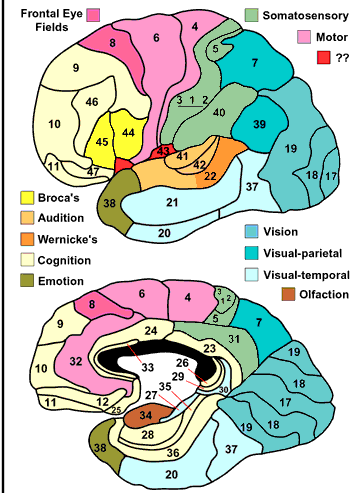lecture 20 - parietal lobes
1/43
There's no tags or description
Looks like no tags are added yet.
Name | Mastery | Learn | Test | Matching | Spaced |
|---|
No study sessions yet.
44 Terms
vestibular organ
mediates balance in the inner ear
consists of two otolith organs and three semicircular canal
balance is processed along with hearing, separate from the other somatosenses
otolith/otoconia
crystals/grains of sand shift around in the vestibular organ, and when the head shifts the grains move and press against the hair cells to trigger AP’s
utricle
senses horizontal motion (forward/backwards, left/right)
saccule
detects vertical movements (up/down)
semicircular canals
filled with jellylike substances that shift along hair cells when the head shifts, and triggers APs
when you spin for some time and then suddenly stop why do you feel that the world is still spinning?
when the semicircular canals detect that you are spinning because of the fluid in them moving, they send an AP to the brain telling it that you’re spinning; however, when you stop, the fluid remains moving for a while in a vortex-like manner, and so the brain still caches that as rotation.
CVIII/C8/Vestibulocochlear Nerve
which cranial nerve deals with the information from the vestibular system?
detecting motion, staying upright, eye movement
purpose of the vestibular system in general
VPL — primary somatosensory cortex
where in the thalamus does info from proprioception/hapsis go?
nuclei in pons/medulla connect at many points
thalamic relays for vestibular information; important for eye movements, how you move your body, audition, and catching yourself when tripping or falling
somatosensory mapping
somatopic (mapped onto the cortex based on body parts (homunculus diagram)
— based on order of nerves that bring in info (cranial nerves, then the rest of the body)
more receptor density from lips and hands than other parts (more cortical real estate)
homunculus
means “little human” — discovered by stimulating different areas in the cortex
size of body parts — how they are mapped cortically
hands/lips huge — high receptor density
shins have almost pain receptors
3a — muscles
3b — skin (slow touch)
1 — skin (fast touch)
2 — joints, pressure
in what sense are there multiple representations of the body on the body for the somatosensory cortex
be able to identify the parietal lobe on sketches

postcentral gyrus (brodmanns 1, 2, 3) $ parietal operculum (brodmann 43)
organization of connections in the anterior zone in the parietal lobe?
brodmanns 5, 7
organization of connections in the superior parietal lobule
supramarginal gyrus (brodmann 40) and angular gyrus (brodmann 39)
connections in the inferior parietal lobe
intraparietal sulcus
controls motor coordination — reaching, eye movement
pathway area 5
handles input from primary sensory areas
handles output to the primary motor cortex (4), supplementary motor area (SMA), and premotor areas (6 & 8)
function: guides movement by giving information about limbs, their position, and movement
pathway: area 7a
input from primary sensory areas (1, 2, 3) secondary sensory (5), motor and premotor cortex, and visual cortex
output to primary motor cortex (4), supplementary motor area (SMA), and premotor areas (6&8)
function: more elaborate movement guidance by giving information about limbs, their position, and movement
area 7b, 39, 40 (dorsal stream)
input from visual, skin sensation, proprioception, auditory, vestibular, oculomotor, and cingulate areas
“parieto-temporal-occipital crossroads”
outputs: many, but especially the prefrontal cortex
function: intermodal integration, spatially guided actions based on visual and tactile information
bottom of angular gyrus, and supramarginal gyrus
which two areas comprise the inferior parietal lobe?
(They receive sensory information, skin sensation, and proprioception, does egocentric space)
route-based
the navigation strategy where you go based on landmarks (go straight and then turn left) — based on recognition
map based
navigation strategy where you have a map in your head (know in general relationships between various landmarks) — requires formation in head
landmark agnosia
not being able to recognize landmarks
What types of information are these areas processing?
MTL: maplike representations
RSC - bookstore at back -what building would you see here etc
Spatial navigation beyond personal space -combine your location with knowledge of landmarks and maps
parahippocampal place area
place in the brain where landmarks are processed
retrosplenial cortex
uses landmark info to figure out where a person is in an environment
medial temporal lobe
creates maplike representations of your environment
arithmetic
“vaguely spatial” because of two reasons:
in arabic numeral system, numbers are read based on where they are spatially
people learned to count mostly with their fingers
dyscalculia
damage to the inferior posterior parietal lobe can lead to _____ which is the inability to do math, and also problems in reading language, or finger agnosia.
alertness/arousal; ascending reticular activating system
one of the four attentional processes that is tasked with focusing attention on something
vigilance/sustained attention; basal forebrain/right hemisphere
one of the four attentional processes tasked with keeping your focus on a stimuli for an extended period of time
selective attention; superior colliculus
one of the four attentional processes tasked with discriminating where your focus goes in the face of many stimuli
attentional control/lateral PFC regions
one of the foura ttention processes tasked with controlling where you focus
selective attention
which attentional process is the parietal lobe very important for
Superior PL
part of the parietal lobe that controls where to attend, and how to shift attention
Inferior PL
part of the parietal lobe that tells you when to shift to important perceptual information
Intraparietal area
part of the PL tasked with weighing and prioritizing info
dizziness
light headed and vague
vertigo
dizzy
very specific way in which the world is spinning around you
feeling occurs for no reason
common with vestibular disorders
hard time staying upright
15/100,000
prevalence of meniere’s disease
vertigo attacks, hearing loss attacks, tinnitus
symptoms of meniere’s disease
antiemetics (for nausea), diuretic (for reduction of fluid), histamine antagonists (for sedative effects)
treatment for meniere’s disease